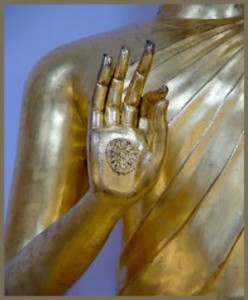Fear and Love
 If you’re like me, you work with fear a lot. Fear comes at us in all kinds of ways, from nagging anxiety over the petty annoyances of life, to worry about difficult relationships and troubling outcomes, to terror in the face of physical danger, serious illness and death. Fear is a survival mechanism — it keeps us from exposing ourselves to unnecessary threats. Yet fear also blocks our path, it keeps us from doing what we want, from speaking the uncomfortable truth, from reaching out. And it fuels our desire to escape from reality into various anesthetics and distractions.
If you’re like me, you work with fear a lot. Fear comes at us in all kinds of ways, from nagging anxiety over the petty annoyances of life, to worry about difficult relationships and troubling outcomes, to terror in the face of physical danger, serious illness and death. Fear is a survival mechanism — it keeps us from exposing ourselves to unnecessary threats. Yet fear also blocks our path, it keeps us from doing what we want, from speaking the uncomfortable truth, from reaching out. And it fuels our desire to escape from reality into various anesthetics and distractions.
One of the most helpful things I’ve learned in my mindfulness practice is how to direct awareness to the way powerful emotions manifest themselves as physical sensations. When a feeling like fear or anxiety arises, I try to investigate it. What is the sensation like, really? Where am I feeling it? How big is it, and where are its boundaries? Does it change as I observe it? As I began to practice this way, I was surprised to learn that if I listened to my sensations, they could reveal things about my emotions that I hadn’t expected.
One morning I was sitting with anger at one of my kids for his lack of effort at school. It wasn’t fun, but I sat and examined the constricted feelings in my chest. After a few minutes of this, the feeling began to shift to a painful tightness in my abdomen that I associate with feelings of anxiety. It occurred to me that the root of what I was feeling wasn’t really anger — it was fear. Fear about what would become of my son was there, but there was also a big dose of fear about what people would think about me as a parent if my child didn’t do well in school. My reaction was so tied up in telling myself stories about my son’s lack of initiative that I wasn’t even aware of what my emotions really were or what they were about — until I turned the stories off and listened to my body.
Not long after, another insight arose as I listened to my body. I’d been dealing with a stressful time at work, and trying to be mindful and curious about the knot in the pit of my gut was getting to be a little exhausting. Just for a change, I did a guided metta meditation practice on my way to work. As I cultivated the warmth in my chest an amazing thing happened — the knot in my stomach went away. With that delightful reinforcement, I started doing more regular metta practice, and I noticed the effect was consistent — if I was feeling the sensation of metta in my heart, I wasn’t feeling the sensation of anxiety in my abdomen. This was four years ago and today I’m convinced that, for me at least, it’s not possible to feel love and fear at the same time.
On reflection, that makes sense. Fear and love are opposite emotions. Fear arises from our aversion, our rejection of potential outcomes, our unwillingness to accept people or what they might do or say to us. Metta is a boundless friendliness that arises when we cultivate good will toward ourselves and others and allow people to be who they are. Fear closes us off and traps us in our conception of ourselves as isolated, vulnerable, wronged. Metta opens us to the experience of our connectedness, to our common birthright of love. Fear says “no” to life; metta says “yes.”
The Karaniya Metta Sutta, one of the very early texts in the Sutta Nipata, makes the contrast plain:
Cultivate an all-embracing mind of love
For all throughout the universe,
In all its height, depth and breadth —
Love that is untroubled
And beyond hatred or enmity.
I’m certainly not untroubled or beyond hatred or enmity. But my mindfulness practice has shown me that it’s possible for fear to arise and pass away without my having to react to it with aversive habits, and that if I choose to there is a way to respond to fearful situations with equanimity and love. For instance, after observing where my anger at my son was really coming from, I realized that what he needed from me was not scolding but love and support — and I actually came up with the courage to tell him that. It’s that occasional glimpse of the freedom that dharma practice offers us that keeps me on the path.
